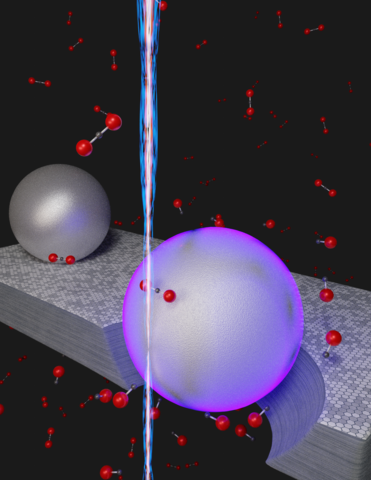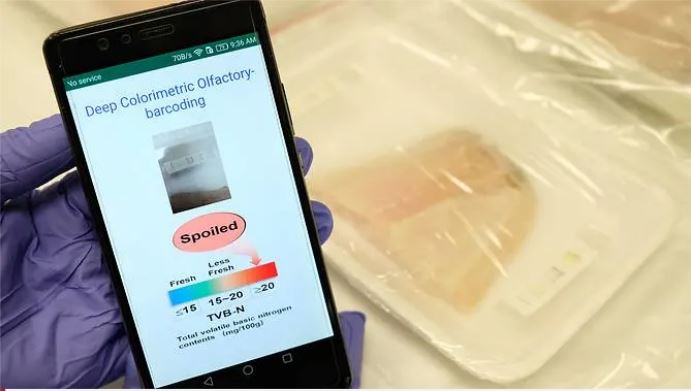(Room Temperature Conversion of CO2 to CO: A New Way to Synthesize Hydrocarbons)
2020/11/2 アメリカ合衆国・国立標準技術研究所(NIST)

・ NIST、米国・メリーランド大学およびオランダ・DENSsolutions が、火力発電所からの CO2 排出の大幅な削減を可能にする、アルミニウムナノ粒子と局在表面プラズモン(LSPs)による室温下の CO2 除去プロセスを開発。
・ 新プロセスは一般的な CO2 の CO への還元手法によるものだが、高温の熱の代わりに局在表面プラズモン(LSPs)を使用する。従来ではアルミニウムが常気圧下で溶解する最低でも 700℃の高温度の熱を使用するため、著しい量のエネルギーが必要となる。
・ LSPs は、アルミニウムナノ粒子上を移動する電子の波が発するエネルギー。従来の高温度、高圧力、高価な貴金属に代わり、LSPs と安価なアルミニウムを使用することでエネルギーとコストを節約する。
・ 室温下でアルミニウムナノ粒子を電子ビームで励起することで、LSPs の振動を引き起こす。電子ビームの直径は調整が可能で、約 1nm のビームが個々のアルミニウムナノ粒子を照射し、その千倍のビームがまとまったナノ粒子上で LSPsを生成する。
・ アルミニウムナノ粒子はグラファイト層に積層しているため、励起エネルギーがグラファイト層へと移動し、グラファイトが CO2 から酸素原子を引き離して CO に還元する。CO は水素と結合させてメタンやエタノール等の有用な炭化水素化合物の製造に利用できる。
・ 透過型電子顕微鏡(TEM)の特殊設計のガスセルホルダーとガスクロマトグラフィー質量分析を組合せて CO2 の ppm 濃度を測定し、CO の生成量を計測。また、電子ビームで可能となる画像化でグラファイトのエッチング量(= CO2 の除去量)を計測 した結果、ガスセルホルダーの出口での CO2 に対する CO の割合は、エッチングで除去された炭素の量と線形的に増大することがわかった。
・ また、電子ビームによる画像では、エッチング量の大部分がアルミニウムナノ粒子付近で起きていることが確認できた。さらに、アルミニウムナノ粒子無しの場合では、エッチングで除去された炭素量が約 1/7 に低減することがわかった。
・ 同技術の実用に向けたスケールアップには、電子ビームの代わりに光ビームによる LSPs 励起が適当と考える。炭素とアルミニウムナノ粒子を充填した透明の容器を発電所の煙突に配置し、光ビームのアレイをグリッドに照射して LSPs を励起する。CO2 ガスが容器を通過する際、ナノ粒子で光励起した LSPs が CO2 を除去するエネルギーを供給する。
URL: https://www.nist.gov/news-events/news/2020/11/room-temperature-conversion-co2-conew-way-synthesize-hydrocarbons
<NEDO海外技術情報より>
(関連情報)
Nature Materials 掲載論文(アブストラクトのみ:全文は有料)
Endothermic reaction at room temperature enabled by deep-ultraviolet plasmons
URL: https://www.nature.com/articles/s41563-020-00851-x
Abstract
Metallic nanoparticles have been used to harvest energy from a light source and transfer it to adsorbed gas molecules, which results in a reduced chemical reaction temperature. However, most reported reactions, such as ethylene epoxidation, ammonia decomposition and H–D bond formation are exothermic, and only H–D bond formation has been achieved at room temperature. These reactions require low activation energies (<2 eV), which are readily attained using visible-frequency localized surface plasmons (from ~1.75 eV to ~3.1 eV). Here, we show that endothermic reactions that require higher activation energy (>3.1 eV) can be initiated at room temperature by using localized surface plasmons in the deep-UV range. As an example, by leveraging simultaneous excitation of multiple localized surface plasmon modes of Al nanoparticles by using high-energy electrons, we initiate the reduction of CO2 to CO by carbon at room temperature. We employ an environmental transmission electron microscope to excite and characterize Al localized surface plasmon resonances, and simultaneously measure the spatial distribution of carbon gasification near the nanoparticles in a CO2 environment. This approach opens a path towards exploring other industrially relevant chemical processes that are initiated by plasmonic fields at room temperature.



